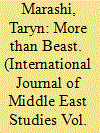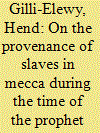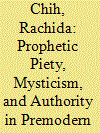|
|
|
Sort Order |
|
|
|
Items / Page
|
|
|
|
|
|
|
| Srl | Item |
| 1 |
ID:
182844


|
|
|
|
|
| Summary/Abstract |
Duldul, a beloved she-mule of the Prophet Muhammad and ʿAli b. Abi Talib (d. 661), fourth caliph and Muhammad's son-in-law, was a venerated riding beast in early Islamic tradition. The article argues that Duldul reflected the transmission of political authority and became a tool of legitimation for hadith compilers and medieval Muslim writers to use, contest, and navigate an emergent Shiʿa-Sunni rift. Exploring the responsive relationship between hadith construction and the Shiʿa-Sunni polemic, the article first analyzes three literary genres—maghāzī, hadith, and sīra—to describe Duldul and her role in early Islamic history. Second, the article examines the writings of al-Jahiz (d. 868) and al-Damiri (d. 1405) to understand medieval Muslim attitudes toward Duldul and she-mules in general. By taking Duldul more seriously as a historical actor, we can gain deeper insight into the disputes over Muhammad's legacy in medieval Islam.
|
|
|
|
|
|
|
|
|
|
|
|
|
|
|
|
| 2 |
ID:
152365


|
|
|
|
|
| Summary/Abstract |
There is hardly a source on early Islam that does not mention slaves in one way or another. They were ubiquitous companions of events, occasions, and incidences. But they played marginal roles in historical accounts. The numerous fragments of information, anecdotes, and offhand references concerning slaves during the rise of Islam call to be collected and analyzed to piece together a picture of various aspects of slavery during this period. References to slaves are especially prevalent in legal texts, as slaves provided useful cases to Muslim jurists to think through legal questions. The discussion of examples of slaves, walāʾ (clientele relationships), and manumission in hadith, exegesis, and jurisprudence has not only provided significant insight into the legal status of slaves, but has also helped scholars to develop a methodology for verifying and evaluating the source material itself. In this essay, I examine pieces of information available in historical and biographical works on early Islam to address the question of the provenance and procurement of slaves in Mecca, Medina, and the Hijaz during the time of the Prophet Muhammad. Reconstructing this story involves dealing with narratives transmitted in various short, spurious, and often unrelated accounts. The source material for early Islam is, as is often pointed out, problematic and at times contradictory. It is laced with topoi and leitmotifs, and frequently proves tendentious, reflecting the opinions and biases of those who wrote them more than what actually happened. Nevertheless, reading beyond the topoi, leitmotifs, and tendentiousness, we find that “in the Traditions there is an undeniable core of ‘fact’” with which we can work and assume to be valid until shown to be false.
|
|
|
|
|
|
|
|
|
|
|
|
|
|
|
|
| 3 |
ID:
188163


|
|
|
|
|
| Summary/Abstract |
In the Maghreb and the Mamluk sultanate during the 15th century, the production of books that encouraged devotion to the Prophet Muhammad—both commentaries on existing texts and new works—increased. This literary production was an expression of the intensification of the veneration of the Prophet that occurred under the influence of Sufis and the political elite. The Arabic devotional literature dedicated to the Prophet began to take shape during the 12th and 13th centuries with the rise of the great saintly sufi figures who laid claim to Prophetic descent and composed celebrated prayers and litanies of blessings upon the Prophet. This article looks at how such texts were critical in the diffusion to popular audiences of doctrinal concepts developed by sufis who placed the figure of the Prophet at the heart of spiritual life and the doctrine of sainthood (walāya). Specifically, it examines a well known but nevertheless understudied 15th-century Moroccan prayer book that is still in use today: Dala'il al-Khayrat (Proofs of Good Deeds). In studying this text, which is both emblematic and exceptional, my aim is to cast fresh light on the novel political, economic, and institutional conditions surrounding the international circulation of an Arabic literature of devotion to the Prophet during the early modern period, and to explore the religious and political implications of these circumstances for sufis of the time.
|
|
|
|
|
|
|
|
|
|
|
|
|
|
|
|
|
|
|
|
|